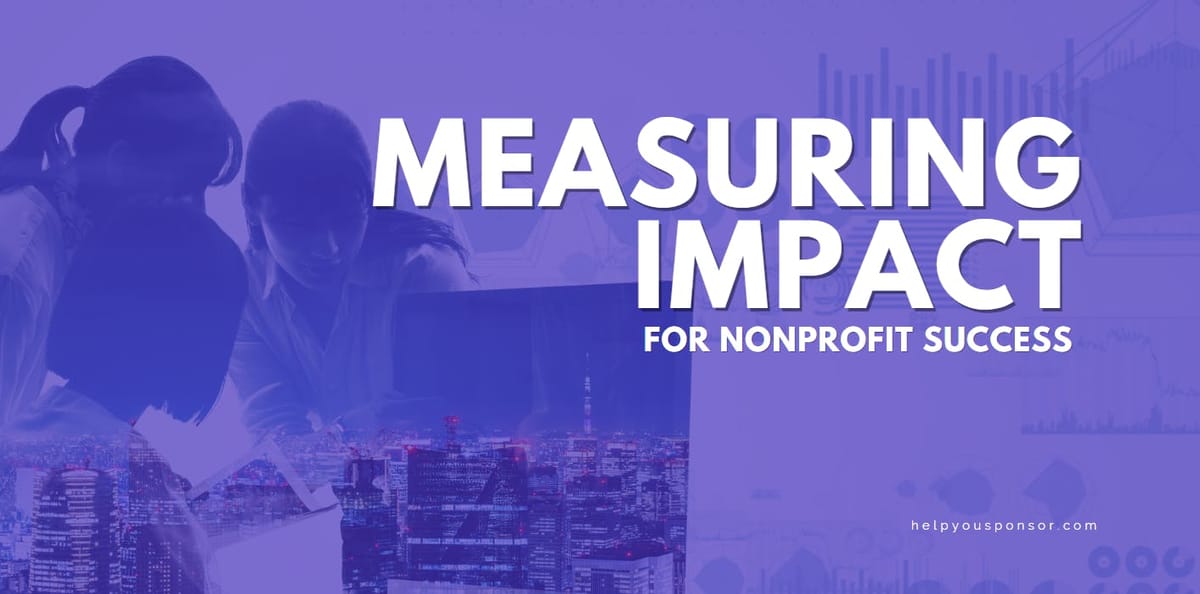Measure What Matters: Revolutionary Approaches to Nonprofit Impact Assessment
Explore innovative impact assessment methods for nonprofits, focusing on long-term change, technology, and collaboration for greater effectiveness.

Nonprofit impact assessment is evolving. Here's what you need to know:
- Old methods focused on simple metrics like dollars raised or people served
- New approaches measure real, long-term change and social impact
- Technology and collaboration are transforming how nonprofits track results
Key new methods:
- Social Return on Investment (SROI)
- Participatory Impact Assessments
- Most Significant Change method
- Big data and AI analytics
- Shared measurement systems
Benefits of modern impact assessment:
| Benefit | Result |
|---|---|
| Better decision-making | More effective programs |
| Increased donor trust | Higher funding |
| Continuous improvement | Greater long-term impact |
| Enhanced collaboration | Ability to tackle bigger issues |
To get started:
- Choose 2-3 key metrics aligned with your goals
- Use free tools like Google Forms for data collection
- Focus on outcomes, not just outputs
- Share both numbers and stories to show your impact
Remember: measuring impact isn't optional anymore - it's crucial for nonprofit success.
Related video from YouTube
Old vs. New Impact Assessment Methods
Nonprofit impact assessment has evolved. Here's how old and new methods compare:
Problems with Old Metrics
Old metrics often fell short:
- Dollars raised: Doesn't show real impact
- People served: Misses long-term effects
- Overhead costs: Can hurt investment
The Nature Conservancy learned this lesson. They protected 12 million acres and had 1.1 million members. But these numbers didn't prove they were saving biodiversity.
"The very act of aligning the mission, goals, and performance metrics of an organization can change it profoundly." - John Sawhill, McKinsey director
New Ways to Measure Impact
New methods focus on actual change:
- Outcome tracking: Measure real improvements
- Long-term studies: Check effects over time
- Personal stories: Show impact through examples
The American Cancer Society set clear goals: cut cancer deaths by 50% and new cases by 25% by 2015. This pushed them to focus on prevention and awareness.
| Old Methods | New Methods |
|---|---|
| Dollars raised | Social return on investment |
| Number of members | Community health improvements |
| Acres protected | Biodiversity increases |
| People served | Long-term outcome tracking |
Nonprofits now use:
- Logic models: Map activities to outcomes
- Data management: Analyze relevant info
- Impact reports: Share results with stakeholders
These new approaches help nonprofits:
- See what works
- Make smart changes
- Show funders real results
"Without understanding outcomes, you can't get at the issue of what works and what doesn't." - Mario Morino, Venture Philanthropy Partners
This shift takes work. But it helps nonprofits do more good and prove their value.
New Metrics for Nonprofit Impact
Social Return on Investment (SROI)

SROI helps nonprofits show their value in dollars and cents. It's like comparing the good you do to the money you spend.
JVS Greater Boston put SROI to work:
| Program | SROI (Year 1) | SROI (Year 2) |
|---|---|---|
| Bridges to College | $1.80 | $3.55 |
| Skills (CNA training) | $1.95 | $3.50 |
The big win? Every $1 invested created $20 in social value. That's a lot of bang for your buck!
"SROI allows for benchmarking across similar programs and provides a basis for comparisons." - JVS Greater Boston SROI Study
Getting People Involved in Assessment
Smart nonprofits are bringing stakeholders into the measurement game. Why? It makes the whole process better.
The Feinstein International Center is all over this. They've even made a guide for Participatory Impact Assessments (PIA) in humanitarian work.
What's in it for nonprofits?
- Better data
- Happier stakeholders
- Fairer evaluations
Finding and Analyzing Results
Want to nail your impact measurement? Here's the playbook:
- Set clear goals
- Pick the right metrics
- Use solid data tools
- Share what you find
Take the American Cancer Society. They aimed to slash cancer deaths by 50% and new cases by 25% by 2015. Talk about laser focus!
Most Important Change Method
This method is all about stories. Real stories from real people about real change.
Here's how it works:
- Gather stories from the people you help
- Let stakeholders pick the best ones
- Double-check the facts
- Spread the word
It's not just about numbers. It's about understanding what REALLY matters to the people you serve.
Using Technology to Measure Impact
Big Data and AI: Game Changers
Big data and AI are revolutionizing impact tracking for nonprofits. These tools process massive data sets and uncover hidden patterns.
Take The Freshwater Trust. This river conservation group used big data to work smarter:
They mapped factors like plants, sunlight, and land slope. Result? Millions saved and new jobs created.
AI goes beyond number crunching. It can:
- Forecast program outcomes
- Identify problem areas
- Guide resource allocation
Imagine predicting a project's success based on past data. Or getting real-time alerts about ongoing program issues.
Child Sponsorship Made Easy
Managing child sponsorships? It's tough. Enter HelpYouSponsor.
This software streamlines:
- Donor and child tracking
- Sponsor-child communication
- Impact monitoring
Users of HelpYouSponsor tools show impressive results:
| Task | Weekly Time Saved |
|---|---|
| Data Entry | 5-10 hours |
| Donor Communication | 3-5 hours |
| Impact Reporting | 4-6 hours |
That's more time for what matters: helping kids.
Don't think tech is just for the big players. Small nonprofits can start with free or cheap tools. Try Google Forms for surveys or Tableau Public for data visualization.
Remember: Technology is a means, not an end. Use it to amplify your impact, not replace human connection.
Working Together on Impact Assessment
Nonprofits are teaming up to measure their impact better. This teamwork helps tackle big social issues.
Group Impact Frameworks
These frameworks help different groups work together on impact evaluation. They create a shared vision and approach.
Take the Strive Partnership in Cincinnati:
"Our 15 Student Success Networks meet every two weeks. They create shared performance indicators and learn from each other", says Jeff Edmondson, Managing Director of Strive Together.
The result? Kindergarten readiness scores went up 10% in just one year.
Sharing Measurement Systems
Sharing data between organizations is crucial. It shows what's working and what's not.
Look at the Elizabeth River Project in Virginia:
| Outcome | Result |
|---|---|
| Land conserved/restored | 1,000+ acres |
| Pollution reduced | 215+ million pounds |
They got 100+ stakeholders to create an 18-point plan for watershed restoration.
John Kania and Mark Kramer, collective impact experts, say:
"Collective impact needs all participants to share a vision for change. This includes understanding the problem and agreeing on actions to solve it."
To make it work:
1. Set clear, shared goals
This aligns everyone's efforts and ensures you're all working towards the same outcome.
2. Decide who does what
Clear roles and responsibilities prevent overlap and ensure all bases are covered.
3. Plan for the long haul
Change takes time. Commit to at least 3-5 years for real impact.
4. Use data to improve
Track progress and adjust your approach based on what the numbers tell you.
Working together isn't just about sharing info. It's about making real, lasting change.
Solving Problems with New Impact Assessment
Nonprofits often hit roadblocks when trying new impact assessment methods. Let's tackle these issues head-on.
Dealing with Limited Resources
Tight budgets? No problem. Here's how to maximize what you've got:
- Use free tools: Google Forms for surveys, Google Data Studio for visuals
- Start small: Pick 2-3 key metrics that match your goals
- Tap existing data: Dig into your client records and financial statements
The Robin Hood Foundation nailed this. They used a data-driven approach to assess programs without breaking the bank. Result? They spotted the most impactful programs and allocated funds smarter, boosting their fight against poverty in NYC.
Training for New Methods
Getting staff up to speed is crucial. Here's the game plan:
1. Set clear goals: Know what success looks like for your training
2. Mix it up: Blend online courses, peer learning, and hands-on practice
3. Keep it going: Schedule regular check-ins and refreshers
4. Measure the training: Use pre and post-assessments to see what works
"On-the-job reflection of core training modules helps evaluate the impact of new skills", says Jeff Edmondson, Managing Director of Strive Together.
Meeting Stakeholder Expectations
Explaining new results to stakeholders can be tricky. Try this:
- Show the 'why': Connect new methods to better outcomes
- Go visual: Use easy-to-grasp charts and graphs
- Tell stories: Pair numbers with real-life impact examples
The International Rescue Committee did this well. They used impact measurement to evaluate and improve programs. The result? Better services and a clearer picture of their impact on refugees and displaced persons.
Real Examples of New Approaches Working
Let's dive into some success stories of nonprofits using new impact assessment methods:
UNICEF Croatia's Virtual Fundraiser

When COVID-19 threatened to cancel their biggest fundraiser, UNICEF Croatia got creative. They teamed up with atlasGO for "The Milky Way Race", a virtual campaign. The results?
- 5,500 participants (aka Milky Way "Stars")
- Over HRK 700,000 raised for maternity wards
This virtual race didn't just save their fundraising. It showed how tech can supercharge community engagement and impact tracking.
World Vision's Community-Focused Approach

World Vision's child sponsorship programs don't just help kids - they boost entire communities. Here's how:
1. They only work where they're invited
2. They team up with local leaders to address specific needs
3. They set clear goals, timelines, and budgets
4. They partner with local churches and government orgs
5. They plan for the long haul (usually 15 years) to ensure lasting change
OneChild's Holistic Sponsorship Model

OneChild goes beyond just sending money. They:
- Invest in young people, not just buildings
- Connect kids with mentors through sponsor letters
- Team up with local churches
Dr. Jacob Kitonsa from OneChild puts it this way:
"When you speak to them [through letters], it's like you're bringing a movie to them and teaching them about life outside their village."
This approach shapes kids' worldviews and self-image for lasting impact.
Environmental Defense's Corporate Partnerships

Environmental Defense switched from suing companies to working with them. Their partnership with McDonald's in the 80s to improve packaging was just the start. Since then, they've influenced hundreds of companies and helped shape major policies like California's Global Warming Solutions Act of 2006.
Key Lessons and Tips
1. Embrace tech: Virtual events and digital tools can expand your reach
2. Get the community involved: Empower locals for better results
3. Think big picture: Combine direct services with advocacy for systemic change
4. Team up strategically: Partnerships can multiply your impact
5. Tell data-driven stories: Use evidence to showcase your impact and attract funding
6. Set SMART goals: Make your objectives specific, measurable, attainable, relevant, and time-bound
7. Mix numbers and stories: Use both to paint a full picture of your impact
What's Next for Nonprofit Impact Assessment
The future of nonprofit impact assessment is about to get a tech makeover. Here's what's coming:
AI-Powered Analytics
AI is set to shake things up. It'll crunch numbers faster than ever, spot trends we might miss, and give real-time feedback. Imagine an AI system that can tell you how people feel about your campaign just by scanning social media. Pretty cool, right?
Blockchain for Transparency
Blockchain isn't just for crypto anymore. For nonprofits, it means:
- Unalterable records
- Real-time donation tracking
- Better fraud protection
| What It Does | Why It Matters |
|---|---|
| Shows everything | Donors trust you more |
| Tracks every penny | You're more accountable |
| Locks it down | Less chance of funny business |
Personalized Impact Reporting
Donors want to see where their money goes. Soon, they'll get:
- Custom reports just for them
- Live updates on projects
- Interactive dashboards with impact stats
Teamwork Makes the Dream Work
Nonprofits are joining forces to measure impact together. Think:
- Shared data platforms
- Standard ways to measure across sectors
- Team research projects
Mixing Numbers and Stories
It's not just about the stats anymore. The future is blending data with real experiences:
- AI reading between the lines of feedback
- Video stories next to number crunching
- Research that uses both hard facts and personal accounts
But here's the thing: with all this tech, nonprofits need to watch out for privacy issues, keep data safe, and make sure AI doesn't play favorites.
The bottom line? Tech is helping nonprofits tell their story better. And that means more support for the good they're doing in the world.
Conclusion
Nonprofit impact assessment has evolved. New methods are reshaping how organizations demonstrate value and create change.
Here's the breakdown:
1. Data-driven decisions
Numbers now guide nonprofit work. This leads to smarter choices and better outcomes.
2. Donor trust
Clear impact data builds confidence. Donors who see real change are more likely to keep giving.
3. Continuous improvement
Regular assessment helps nonprofits identify what works and what doesn't. They can then optimize their programs for maximum impact.
4. Tech tools
New software simplifies tracking and reporting. This frees up time and resources for nonprofits to focus on their mission.
5. Collaboration
Shared measurement systems are gaining traction. Nonprofits working together can tackle larger issues more effectively.
It's not just about tools - it's about mindset. Nonprofits must embrace these new approaches to stay relevant and effective.
What nonprofits can do now:
- Start small: Focus on measuring one program in-depth.
- Use free tools: Leverage social media to share impact data creatively.
- Ask for help: Many funders offer support for impact measurement.
- Be open: Share successes and setbacks. Honesty builds trust.
It's okay to stumble at first. The key is to start measuring and keep improving.
John Mark Vanderpool, Co-Founder of Social Impact Solutions, puts it simply:
"We can't market without measurements."
This captures it perfectly. Today, showing impact isn't optional - it's crucial.
By adopting these new approaches, nonprofits can:
| Benefit | Result |
|---|---|
| Make better decisions | More effective programs |
| Build stronger donor relationships | Increased funding |
| Improve continuously | Greater long-term impact |
| Collaborate more effectively | Tackle bigger challenges |
The future of nonprofit work is data-driven, transparent, and collaborative. It's time for all nonprofits to start measuring what truly matters.
FAQs
How to measure the impact of a nonprofit?
Measuring nonprofit impact isn't just about counting numbers. It's about showing real progress towards your goals. Here's what you need to know:
Key metrics to track:
| Metric Category | Examples |
|---|---|
| People Served | - Number of individuals helped - Percentage of clients achieving goals |
| Volunteer Engagement | - Total volunteer count - Hours contributed by volunteers |
| Financial Health | - Number of donors - Total donations received - Average gift size - Fundraising expenses |
| Program Effectiveness | - Completion rates of programs - Improvements in participant outcomes |
Let's look at a real-world example. In 2022, Children International reported:
- 100,000 medical and dental services provided
- 20,000 adolescents in health programs
- 92% completion rate in tutoring programs
Want to measure impact like a pro? Here's how:
1. Set clear goals that match your mission
2. Pick metrics that actually show progress
3. Gather data consistently
4. Look at your results and find ways to improve
5. Tell your stakeholders what you've found
Here's the kicker: focus on outcomes, not just outputs. As Marc J. Epstein, who wrote "Measuring and Improving Social Impacts", puts it:
"If an organization is unclear or does not communicate clarity on what they specifically want to achieve, it will be more difficult to measure whether their activities or other factors caused changes. So the clarity is critical for both achieving and measuring success."
In other words: know what you want to achieve, and you'll know if you're actually making a difference.

